Figure 1.
Aflibercept treatment algorithm for nAMD after year 1, 2017 update.
Notes: aSeventh injection in year 1; bIf visual and/or anatomic outcomes deteriorate, the treatment interval should be shortened accordingly. The Royal College of Ophthalmologists guidelines for nAMD advise that hyperactive lesions may for a short time require more intensive therapy, at the discretion of the treating clinician; cPatients must meet at least one “Criteria for considering not extending”; dMacular fluid refers to intraretinal/subretinal fluid; eDefined as meeting at least one “Criteria for considering not extending”; fReturn to the previous treatment interval at which the macula remained dry; gOnce the optimal dosing interval has been identified, fix the dosing at this interval for three consecutive injections before considering extending further; hFellow eye involvement may drive the monitoring/retreatment interval; iIn the opinion of the treating clinician; jThe next initial monitoring visit may take place 4–6 weeks later at the discretion of the treating clinician. Subsequent monitoring intervals without treatment should then be extended by 4 weeks at a time, up to a maximum of 12 weeks; kThe status of the fellow eye must be considered in any discharge assessment/decision; lRequirement for loading is at the discretion of the treating clinician.
Abbreviation: nAMD, neovascular age-related macular degeneration.

